The AMD Radeon R9 290X Review
by Ryan Smith on October 24, 2013 12:01 AM EST- Posted in
- GPUs
- AMD
- Radeon
- Hawaii
- Radeon 200
Company of Heroes 2
Our second benchmark in our benchmark suite is Relic Games’ Company of Heroes 2, the developer’s World War II Eastern Front themed RTS. For Company of Heroes 2 Relic was kind enough to put together a very strenuous built-in benchmark that was captured from one of the most demanding, snow-bound maps in the game, giving us a great look at CoH2’s performance at its worst. Consequently if a card can do well here then it should have no trouble throughout the rest of the game.
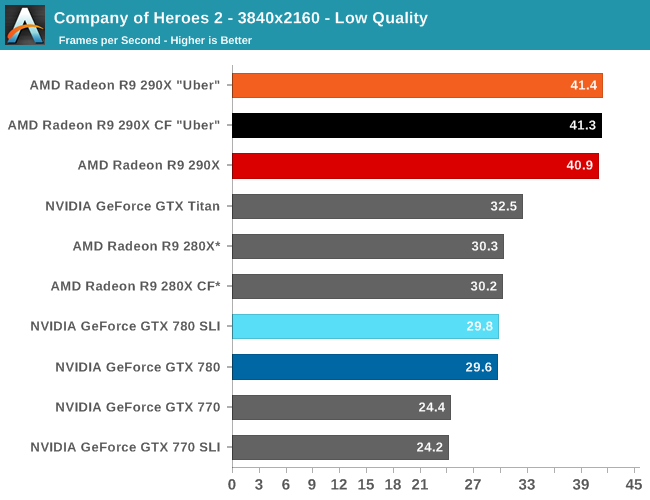
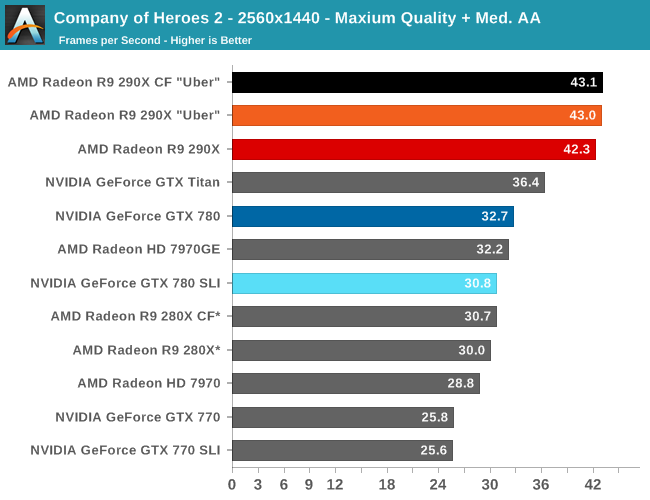
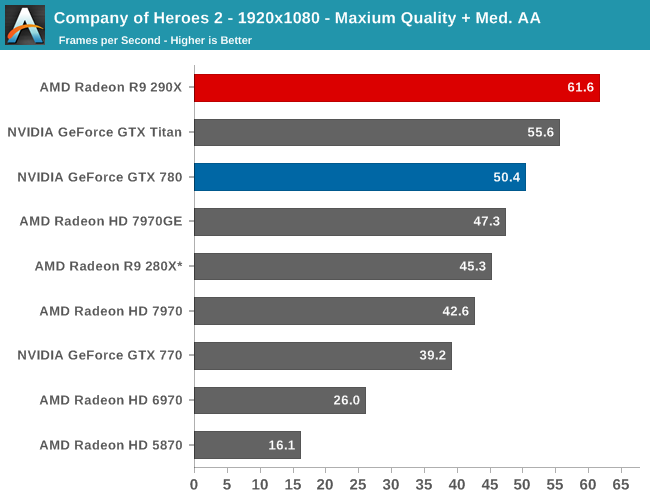
Our first strategy game is also our first game that is flat out AFR incompatible, and as a result the only way to get the best performance out of Company of Heroes 2 is with the fastest single-GPU card available. To that end this is a very clear victory for the 290X, and in fact will be the largest lead for the 290X of all of our benchmarks. At 2560 it’s a full 29% faster than the GTX 780, which all but puts the 290X in a class of its own. This game also shows some of the greatest gains for the 290X over the 280X, with the 290X surpassing its Tahti based predecessor by an equally chart topping 41%. It’s not clear what it is at this time that Company of Heroes 2 loves about 290X in particular, but as far as this game is concerned AMD has put together an architecture that maps well to the game’s needs.
Briefly, because of a lack of AFR compatibility 4K is only barely attainable with any kind of GPU setup. In fact we’re only throwing in the scale-less SLI/CF numbers to showcase that fact. We had to dial down our quality settings to Low on CoH2 in order to get a framerate above 30fps; even though we can be more liberal about playable framerates on strategy games, there still needs to be a cutoff for average framerates around that point. As a result 280X, GTX Titan, and 290X are the only cards to make that cutoff, with 290X being the clear winner. But the loss in quality to make 4K achievable is hardly worth the cost.
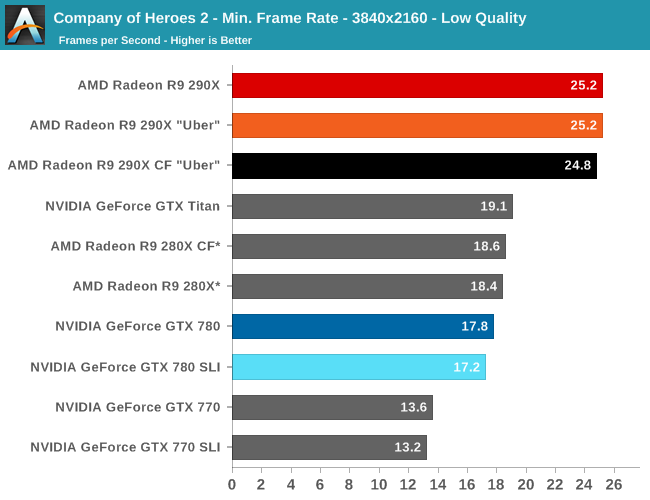
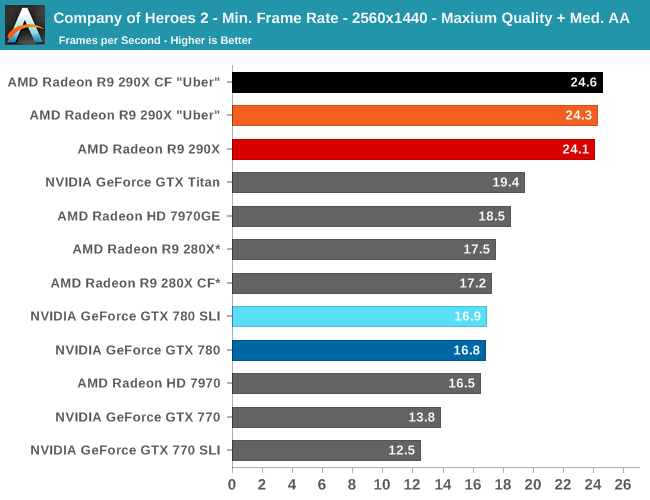

Moving on to minimum framerates, we see that at its most stressful points that nothing, not even 290X, can keep its minimums above 30fps. For a strategy game this is bearable, but we certainly wouldn’t mind more performance. AMD will be pleased though, as their performance advantage over the GTX 780 is only further extended here; a 29% average performance advantage becomes a 43% minimum performance advantage at 2560.
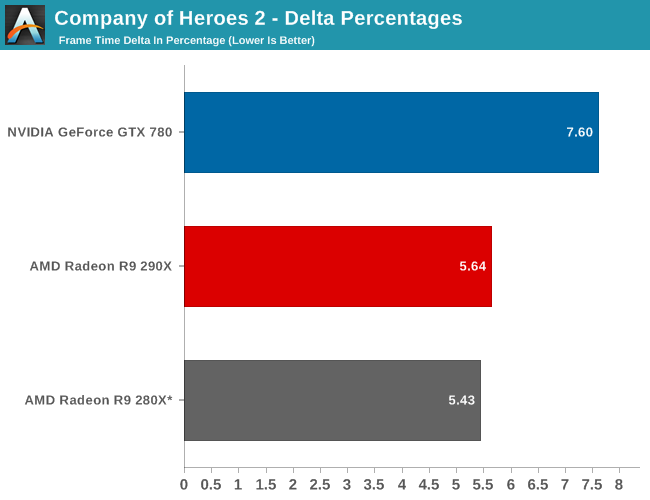
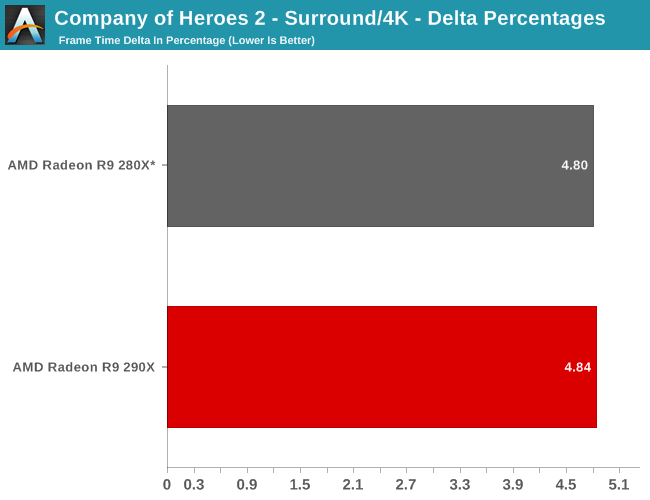
Finally, while we don’t see any performance advantages from AFR on this game we did run our FCAT benchmarks anyhow to quickly capture the delta percentages. Company of Heroes 2 has a higher than average variance even among single cards, which results in deltas being above 5%. The difference between 5% and 7% is not going to be too significant in practice here, but along with AMD’s performance advantage they do have slightly more consistent frame times than the GTX 780. Though in both the case of the 280X and the 290X we’re looking at what are essentially the same deltas, so while the 290X improves on framerates versus the 280X, it doesn’t bring with it any improvements in frame time consistency.










396 Comments
View All Comments
xres625e - Thursday, October 24, 2013 - link
sterven..eddieveenstra - Sunday, October 27, 2013 - link
stoere jongen ben je.... bah.TrantaLocked - Sunday, October 27, 2013 - link
Hm I wonder why I can find the 290X for $550 on newegg?Dal Makhani - Thursday, October 24, 2013 - link
lol AMD fanboy. This card is alright, nothing "uber". It brings some proper pricing sense back into the green team's head which is needed, the gtx 780 will be dropped to R9 290X pricing, and the 780 Ti will be Nvidia's new 650 dollar card. But to justify 100 dollar price difference, i dont know if 780 Ti can show big enough gains. That will be interesting to see next month.tuklap - Thursday, October 24, 2013 - link
I doubt that nvidia gtx 780 will drop price on par with r9 290x..just4U - Thursday, October 24, 2013 - link
I doubt it as well.. They didn't ever really drop prices on the 560Ti until it EOL..mfergus - Thursday, October 24, 2013 - link
Well it's uber in the sense that it brings much needed competition to Nvidia's very high priced high end cards. Nobody should of thought this card was going to be revolutionary though, it's on the same 28nm as all the other cards and it has the same architecture as the 7790 which had very minor compute changes compared to GCN 1.0dragonsqrrl - Thursday, October 24, 2013 - link
Dropping the 780 by $100 is the very least Nvidia would have to do to remain competitive, and personally I don't think that would be nearly enough. The 290X is performance competitive with Titan, and despite the fact that Titan is cooler, quieter, consumes less power, has a much better shroud, and superior DP performance, it should come down to the same price as the 290X to remain competitive due to the slightly higher performance of the 290X. A ~$550 Titan or ~$400 780 would be amazing.mfergus - Thursday, October 24, 2013 - link
I don't expect Titan's price to change much but I could be wrong. I never really thought of it as a standard gaming card, it's a total halo product with lots of memory and the only non Quadro/Tesla with full DP performance. The 780ti will be cheaper than Titan though and faster in gaming performance.Bloodcalibur - Thursday, October 24, 2013 - link
You truly are an idiot if you think that the Titan should be compared to a 290X and that the sentence ends there. The Titan itself only performs a small bit above nvidia's own 780, but the $350 price difference is there for it's compute performance. It's basically a budget workstation card with higher than 780 gaming abilities for those who game AND do a little bit of 3D computing. Derp.This retard actually suggested a gaming/workstation hybrid pried at $1000 should compete downwards with a $550 gaming card.